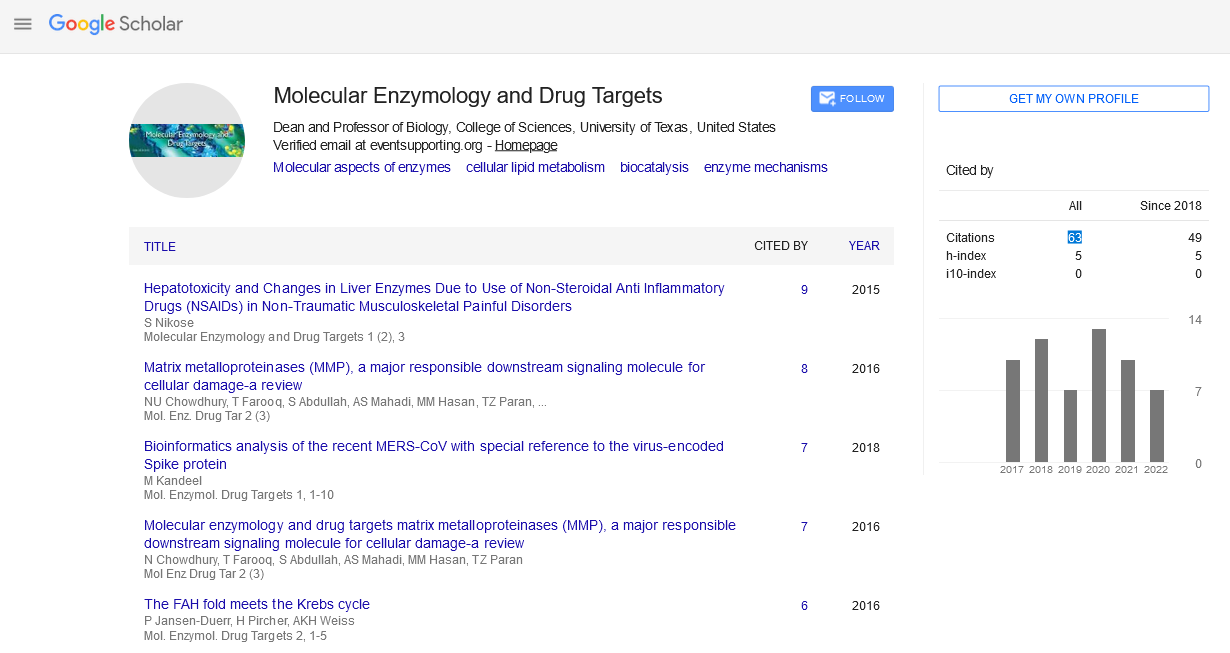Commentary - (2022) Volume 8, Issue 3
A short note on Investigation of DNA-protein Sequence-Specific Interactions with a ds-DNA Array
1Chien-Shiung Wu Laboratory, Department of Biological Science and Medical Engineering, Southeast University, Nanjing 210096, P.R. China
*Correspondence:
Zuhong Lu, Chien-Shiung Wu Laboratory, Department of Biological Science and Medical Engineering, Southeast University, Nanjing 210096,
P.R. China,
Tel: (+86)-25-83792245,
Email:
Received: 02-May-2022, Manuscript No. Ipmedt-22-13012;
Editor assigned: 03-May-2022, Pre QC No. Ipmedt-22-13012 (PQ);
Reviewed: 16-May-2022, QC No. Ipmedt-22-13012;
Revised: 23-May-2022, Manuscript No. Ipmedt-22-13012 (R);
Published:
30-May-2022
Abstract
The use of double-stranded DNA arrays (ds-DNA arrays) for studying sequence specific recognition between DNAs and proteins is a promising method. Here we report the use of a ds-DNA probe with multi operation sites of restriction proteins in the middle sequence to investigate DNA-protein sequence-specific interactions including methylation. We arranged EcoR I site and RNA I site on the same duplex DNA probe to fabricate ds-DNA arrays. We used the ds-DNA arrays to study DNArestriction enzyme reactions before and after duplex DNA methylation under different probe concentration and reaction time conditions. Our results indicated that the ds-DNA arrays can be further biochemically modified and made accessible for interactions between DNAs and proteins in complex multi-step gene-regulation processes.
Keywords
ds-DNA array; Restriction enzymes; Methylase; DNA-protein interactions.
INTRODUCTION
DNA-proteins sequence-specific interactions play important roles in regulating cellular processes such as transcription, recombination, restriction, replication and DNA-drugs interaction. Several methods have been developed to analyse the DNA-protein sequence-specific interactions, which are mainly gel-shift assays and DNase foot-printing assays [1]. However, they are not only laborious, time-consuming and incapable of providing highly parallel analysis, but also they are not suitable for analysing the complex multi-step protein-DNA interactions. Most DNA arrays are made of ssDNA, and recognize the target DNA through hybridization. Unlike arrays used for gene sequencing, a new type of DNA arrays, double-stranded DNA (ds-DNA) arrays should be fabricated for detecting sequence-specific regulatory DNA-binding proteins [2]. Preliminary studies of double-stranded DNA arrays suggested that these ds-DNA arrays are well suited for the analysis of DNA–protein interactions, particularly for the discovery of the sequences recognized by transcription factors and the quantitative assessment of those important interactions. As we know, a number of DNA–protein interactions require that the DNA be biochemical modified in some way. For example, restriction-modification systems occur in many bacterial species, and constitute a defense mechanism against the introduction of foreign DNA into the cell. We arranged EcoR I site and Rsa I recognition site on the same duplex DNA probe to fabricate ds- DNA arrays and labeled the ds-DNA probes during the ds-DNA arrays creation previously and then used the ds-DNA arrays to study DNA-restriction enzyme reactions before and after duplex DNA methylation under different probe concentration and reaction time conditions. Our results indicated that the ds-DNA arrays can be further biochemically modified and that the DNA is accessible for interaction with DNA-binding proteins in complex multi-step gene-regulation processes.
Description
DNA/protein interactions on the fabricated ds-DNA arrays, ds-DNA arrays which had been inserted with Cy3-dUTP were used for digestion with EcoR I and Rsa I, respectively [3]. The digestion efficiency was affected by the concentrations of the ds-DNA probes and reaction time, four different concentrations (80 μM, 40 μM, 20 μM, 10 μM) and two different reaction times (1 h, 12 h) were tested in this experiment. To avoid the signal intensity loss caused by background decrease, we calculated the intensity ratios between experimental spots and controls to compare the signal change before and after incubation [4]. The data showed that there were no significant signal losses after the EcoR I digestion of the ds-DNA array which had been previously treated with EcoR I methylation enzyme. However, the ds-DNA array after Rsa I incubation presented significant signal decrease when previously treated with EcoR I methylase. This combination of a specific methylase and endonuclease functioned as a type of immune system for individual bacterial strains, protecting them from infection by foreign DNA. In any cell with a RM system, both the restriction and modification enzymes have the same sequence specificity. The EcoR I endonuclease within the same bacteria will not cleave the methylated DNA. Foreign viral DNA, which is not methylated at the sequence "GAATTC" will therefore be recognized as "foreign" DNA and will be cleaved by the EcoR1 endonuclease. DNA arrays designed in various formats will have broad applications in studying protein-DNA interactions, including inhibitors/activators of sequence specific transcription factors, or synergy among transcription regulators. We also anticipate that ds-DNA arrays will be very effective substitutes for many tedious protein-DNA interaction assays currently used in the field, such as gel mobility shift assays, filter binding assays, etc. Endonucleases (EcoR I, Rsa I) and EcoR I methylase were obtained from New England BioLabs. Sodium borohydride, SDS (Sodium dodecyl sulfate), methanol, acetone and buffer components were all purchased as ACS grade reagents from Sigma Chemical Company. All the oligonucleotide probes were dissolved in 0.1mol/L Na2CO3-NaHCO3 buffer (30% 0.1 M Na2CO3 with 70% 0.1 M NaHCO3, pH 9.5 at RT) [5]. Deionized distilled water was purified by Milli-Q® (Millipore Corp.). 20×SSC buffer (Saline-Sodium Citrate buffer) was prepared as follow: NaCl (35.06 g) and sodium citrate (17.64 g) were dissolved in deionized distilled water (180 mL); the pH was adjusted to 7.0 with NaOH, the solution was made up to 200mL and then autoclaved before use. To use 20×SSC, it was simply diluted with an appropriate amount of distilled/deionized water.
Acknowledgement
None
Conflict of interest
No conflict of interest
REFERENCES
- Polisky B , Greene P, Garfin DE, McCarthy BJ, Goodman HM(1975) et al. Specificity of substrate recognition by the EcoRI restriction endonuclease. Proc. Natl. Acad. Sci. USA72, 3310–3314.
Indexed at, Google Scholar, Crossref
- Thielking V, Alves J, Fliess A, Maass G, Pingoud A(1990) Accuracy of the EcoRI restriction endonuclease: binding and cleavage studies with oligodeoxynucleotide substrates containing degenerate recognition sequences. Biochem. 29, 4682–4691.
Indexed at, Google Scholar, Crossref
- Lesser DR, Kurpiewski MR, Jen-Jacobson L(1990) The energetic basis of specificity in the EcoRI endonuclease–DNA interaction. Science .250, 776–786.
Indexed at, Google Scholar, Crossref
- McClarin JA, Frederick CA, Wang BC, Greene P, Boyer HW (1986) et al. J.M.Structure of the DNA–EcoR I endonuclease recognition complex at 3 Ǻ resolution. Science,234,1526–1540.
Indexed at, Google Scholar, Crossref
- Rubin RA, Modrich P(1977). EcoR I Methylase: Physical and catalytic properties of the homogeneous enzyme. J. Biol. Chem. 252, 7265-7272.
Indexed at, Google Scholar
Citation: Lu Z (2021) A short note on
Investigation of DNA-protein Sequence-
Specific Interactions with a ds-DNA Array.
Mol Enzy Drug Targ, Vol.8 No. 3: 103.





